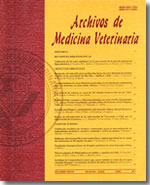An in vitro study of potential attachment sites for the reconstruction of the medial collateral ligament of canine stifles
Main Article Content
Abstract
Rupture of the medial collateral ligament (MCL) results in joint instability of the stifle in dogs and should be surgically repaired as early as possible. Placement of a prosthetic ligament in the most isometric position is necessary to maintain joint stability avoiding excessive tension or loosening on the implant during joint motion. The objective of the present study was to determine the potential isometry of three anchor paired sites in canine cadaveric stifles. The length from a femoral marker to each of 3 medial tibial markers was determined from radiographs of each limb in different joint angles (maximal extension, 130° and maximal flexion). None of the anchor combinations were isometric. All combinations had low increase in length on stifle extension and a pronounced decrease on stifle flexion. The least change in length was measured on the more distal tibial anchor marker. The present study demonstrates that some locations for the origin and insertion of a prosthetic MCL are associated with less length change.

